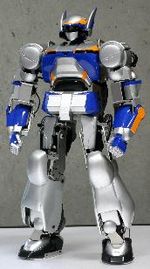
Choromet
Encyclopedia

Humanoid robot
A humanoid robot or an anthropomorphic robot is a robot with its overall appearance, based on that of the human body, allowing interaction with made-for-human tools or environments. In general humanoid robots have a torso with a head, two arms and two legs, although some forms of humanoid robots...
which is, in a sense, the younger brother of HRP-2. It runs on ART-Linux which is a hard realtime linux
Linux
Linux is a Unix-like computer operating system assembled under the model of free and open source software development and distribution. The defining component of any Linux system is the Linux kernel, an operating system kernel first released October 5, 1991 by Linus Torvalds...
developed at the National Institute of Advanced Industrial Science and Technology
National Institute of Advanced Industrial Science and Technology
The , or AIST, is a Japanese research facility headquartered in Tokyo, and most of the workforce is located in Tsukuba Science City, Ibaraki, and in several cities throughout Japan. The institute is managed to integrate scientific and engineering knowledge to address socio-economic needs...
in Japan
Japan
Japan is an island nation in East Asia. Located in the Pacific Ocean, it lies to the east of the Sea of Japan, China, North Korea, South Korea and Russia, stretching from the Sea of Okhotsk in the north to the East China Sea and Taiwan in the south...
. Choromet's CPU is an SH-4(SH7751R) which runs at 240 MHz and has 32 MB of Random access memory and 32 MB of Flash ROM.
Choromet is capable of a wide range of motion. It can stand on one leg, walk, and wave. It also has the ability to sit down and lie flat on its back (or face), then stand back up again (the HRP-2 model was also able to do this).
Choromet was developed in partnership between General Robotix, Inc. and Moving Eye, Inc., Pirkus Robotics and Dai Nippon Technical Research Institute. http://www.aist.go.jp/aist_e/latest_research/2006/20060713/20060713.html
What differentiates Choromet from similar little humanoid robots is that it is equipped with a large number of sensors. This means that it can be programmed using feedback loops. Due to its complexity and price, Choromet is not so much a toy as a research platform.
Software modules that require real-time processing are written as plugins in C++
C++
C++ is a statically typed, free-form, multi-paradigm, compiled, general-purpose programming language. It is regarded as an intermediate-level language, as it comprises a combination of both high-level and low-level language features. It was developed by Bjarne Stroustrup starting in 1979 at Bell...
and the plugin-manager itself is scriptable in stackless Python (programming language)
Python (programming language)
Python is a general-purpose, high-level programming language whose design philosophy emphasizes code readability. Python claims to "[combine] remarkable power with very clear syntax", and its standard library is large and comprehensive...
. This system is similar to the software used in the HRP series humanoid robots except for the fact that it does not include CORBA
Common Object Request Broker Architecture
The Common Object Request Broker Architecture is a standard defined by the Object Management Group that enables software components written in multiple computer languages and running on multiple computers to work together .- Overview:CORBA enables separate pieces of software written in different...
.
It has a triaxial force/torque sensor each leg and accelerometer and gyro sensors in its trunk. There are no cameras on the robot at this point because initial focus is on locomotion.
Pricing is 498,750 yen
Japanese yen
The is the official currency of Japan. It is the third most traded currency in the foreign exchange market after the United States dollar and the euro. It is also widely used as a reserve currency after the U.S. dollar, the euro and the pound sterling...
and sales are restricted to Japan only.
This price places Choromet firmly within the means of most small-budget research labs, even those labs dealing with multi-agent programs requiring the simultaneous co-ordinated use of several robots.

